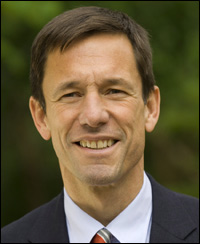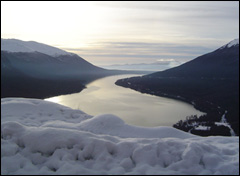The stereotypes of biz-begrudging enviros and planet-pillaging business leaders were upended years ago. These days, green groups and corporations team up on everything from preserving land to pushing for climate regulations. Now, in the latest example of cross-pollination, they’re even swapping executives.

Mark Tercek
Photo: Mark Godfrey/The Nature Conservancy
Mark Tercek, who took the helm of The Nature Conservancy this week, spent more than two decades as an investment banker and managing director at Wall Street giant Goldman Sachs. In recent years, he oversaw the company’s Environmental Strategy Group and Center for Environmental Markets, and pioneered Goldman’s sustainability initiative, which includes commitments to use recycled office products, report publicly on the firm’s carbon footprint, and invest in emerging green sectors. During his tenure, Goldman invested $1.5 billion in renewables and clean technology and helped preserve 680,000 of pristine wilderness in Chile’s Tierra del Fuego region.
Still, what makes a go-getting moneyman the right leader for a conservation organization? How compatible are conservation goals with the bottom line? I spoke to Tercek recently to find out.
(Full disclosure: Amanda Griscom Little’s brother is an employee at The Nature Conservancy.)
Why did you leave Wall Street for the world of green advocacy?
I’m a long-time admirer of The Nature Conservancy. I think its mission — to conserve biodiversity on a global basis — is an absolutely vital one. For me to have the opportunity to put to work everything I’ve learned over 24 years at Goldman Sachs to help the team at The Nature Conservancy achieve its mission — how could I say no? How could I resist that kind of incredible opportunity?
What skills from your business background prepare you for the job?
Goldman Sachs is a hard-charging, ambitious organization that seeks to get difficult things done by collaborating effectively with other people — by consensus-building and rallying people together to pursue important tasks. The firm has produced very capable leaders who have gone off to do very interesting things — leaders like Hank Paulsen, secretary of Treasury; Gov. [Jon] Corzine [of New Jersey]; and Bob Rubin, former secretary of Treasury.
I’ve had the good fortune at Goldman Sachs to have a couple of important leadership positions, most recently spearheading our efforts in the environmental area. I think I’ve learned about how to unite people around ambitious, clear goals and achieve those goals in the most direct, efficient, and fulfilling way.
What inspired you to make the environment a focus in your work?
As a citizen of the world, I have a tremendous sense of appreciation for the natural world — for the services the ecosystem presents and provides to us. As a parent, my wife and I have tried to expose our kids to the great wonders of the natural world, and that has reinforced my interest in the environment. And over the last five years, I’ve become increasingly engaged with and concerned about the environmental problems the world confronts today. So right now I feel very fortunate, genuinely and 100 percent fortunate, to have been selected to lead The Nature Conservancy.
I like your phrasing — “the services the ecosystem presents and provides to us.” It has the ring of a banker’s pragmatism. Can you elaborate on the values yielded by ecosystems?
The benefits that the natural world provides mankind are obviously enormous, valueless. You can’t quantify them in a crass, accountant-like way. The wonders of biodiversity are sufficiently important that they, in and of themselves, should motivate tremendous effort toward conservation. Further, there are spiritual benefits — people might use other words — that flow to mankind from biodiversity that justify conservation efforts.
But if you want to go even further in the analysis and look at the more concrete ecosystem services that nature provides, these economic values are staggeringly large. Academics, scientists, economists are only beginning to think hard and comprehensively about how to value them. If you think about forests acting as lungs for the planet, or forests as stores of carbon, or forests as sources of providing clean water, protecting rivers from silt, providing flood control — you can just keep ticking through the natural world and the economic value of its services is huge.
I think you could say these economic values have never been properly calculated or factored into an enormous range of economic decision-making. Organizations like The Nature Conservancy have a great opportunity to help governments and businesspeople better understand the dollar-and-cents values of those services.
A Bush administration official once told me she believed that the invisible hand of Adam Smith has “a green thumb.” Do you believe that markets can be trusted to move in the direction of the greener good?
Markets can do a tremendous amount of good here, but I think there’s often the need for regulatory intervention to make things happen in the right way. Consider greenhouse-gas emissions, for instance: They impose a cost — an “externality” in economic terms — on society. If you don’t put a price on emitting those pollutants, you’ll have, as a result, bad decisions and bad outcomes. So I believe that regulatory measures such as a cap-and-trade program are needed, and that, properly structured, the market can allow very good things to happen.
We often hear these days that “green is green” — that protecting the environment fattens the bottom line. But this is not always true. When are profit motives incompatible with environmental goals?
There are lots of win-win opportunities for the private sector to do things that are good for their business and also good for the environment. On the other hand, there are also instances when private interests and the public good don’t overlap. And it’s in those instances that we need good regulatory oversight.
The Nature Conservancy has historically been fairly apolitical and steered clear of lobbying and advocating for particular policies. Going forward, do you see the Conservancy lobbying for specific climate policy?
The Nature Conservancy’s mission is protecting nature to conserve biodiversity. Climate change poses an enormous risk not only to everything that the Conservancy will seek to do going forward, but everything it has already done. We are members of the United States Climate Action Partnership, and as part of that coalition we’ve endorsed a policy approach for legislation that puts a price on emitting carbon, but in a market-friendly way. We also see a role for the Conservancy in helping shape policies that provide incentives for reducing deforestation.
Last year Goldman Sachs brokered a deal to prevent a number of planet-warming coal plants from being built in Texas. Do you plan to be fighting against coal plants in your new role at the Conservancy?
The Conservancy is in the process of developing a comprehensive energy platform that will inform our work moving forward. For now, I can tell you that you should expect to see the Conservancy partnering with businesses and governments alike to work toward achieving our mission.
The Nature Conservancy gets large corporate donations. Is there a conflict of interest that arises when an NGO is presented with corporate money?
We’re very careful in all of our fundraising to not put ourselves in the position of conflict so that our fundraising ever gets in the way of our objectives. We are focused like a laser on our core mission, and we would never let our fundraising get in the way of that.
Do you have to vet the backgrounds of the companies that donate to be sure they haven’t been involved in any major environmental transgressions?
We try to be very careful about all of the ways we operate and all of our partnerships with companies, multilateral organizations, government, other environmental organizations, so that the work we do is never tainted or upset.
One of the challenges The Nature Conservancy has encountered when protecting valuable ecosystems around the world is collaborating with indigenous people who work and live around these areas. How should conservation groups deal with local communities in the regions you’re trying to protect?
Conservation will only work, by and large, if it works for the people who live in the area where positive outcomes are being sought. There really aren’t left in the world any more large areas without people. We try very hard to pursue conservation opportunities that have a whole host of benefits but always, importantly, start with and include the local folks who live there.
In 2003, The Nature Conservancy was criticized for controversial land deals and other practices. What will you do as president to ensure that the organization maintains high ethical standards?
We are tremendously committed to and focused on acting at the highest level of transparency and good governance. My board fully supports me; my senior management team is focused on that. It’s an enormously high priority to get those matters right. In my read, the organization has all the right resources in the right places to make that the likely outcome.
Who is your environmental hero?
It’s hard to pick a single one. The names that immediately arise are E.O. Wilson, who has taught me a lot about appreciating the beauty and wonder and preciousness of biodiversity. The work of Gretchen Daily has helped me understand the value of ecosystem services. The work of Jared Diamond has made me more cognizant of how mankind can make big mistakes.
What do you and your family do at home to lighten your environmental footprint?
On a day-to-day basis, my family is trying hard to improve its behavior so that we reduce our footprint, but we are very humble about this and we have a long way to go. Living in New York has been great, because we can commute by public transportation and get around town on foot in a way that is fantastic.
Can you share an anecdote about a favorite outdoor or wilderness adventure?
An experience my family and I recently enjoyed was hiking for 10 days in the glaciers of the Torres del Paine region in Patagonia. As a family in modern-day America, it’s hard ever for us all to be together, undistracted by the modern world — much less in a place so beautiful.
Of all the striking ecosystems you’ve visited, which has been your favorite?
Tierra del Fuego. Its beauty is just extraordinary — you’d need to be a poet to put it into words. And it’s interesting and encouraging to me that private-sector actors — Goldman Sachs in collaboration with environmental organizations — could come together along with the Chilean government to protect in perpetuity this enormous area the size of Rhode Island for the benefit of Chilean people. It excites me to think that we’re at a turning point where there’s even more opportunity to [replicate this kind of collaborative conservation model] over and over, throughout the world. The private sector is waking up and understanding the stakes and the opportunity. So new players are working in concert with the traditional players to make even more great things happen.



